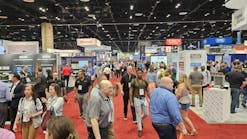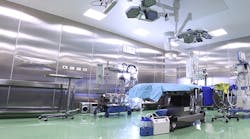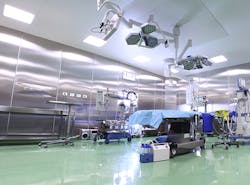The operating room (OR) typically is among the greatest sources of revenue for a hospital and, thus, kept as busy as reasonably possible. The “occupied period” of a typical OR may start before 6 a.m., when nurses and support staff begin to prepare the surgical environment. The performance of procedures typically begins at 7 a.m. and continues into the evening, sometimes until after 9 p.m., followed by a closing hour of post-surgical occupancy.
With use like that, it should come as no surprise ORs account for a significant portion of an institution’s overall energy use. This article discusses the role of proper surgical-suite environmental control and energy management in the cost-efficient operation of a hospital and provides examples of four hospitals in the Southeastern United States that completed successful energy-efficient environmental upgrades.
The Evolution From Prescriptive and Quantitative to Performance-Based
In the United States, policymakers are changing the ways they evaluate ORs and other components of health-care delivery, moving away from old standards of care and reimbursement formulas.
In prior eras, standards were largely prescriptive. For example, codes would require a hospital to meet certain criteria, such as standards set by ASHRAE or guidelines established by The American Institute of Architects. Additionally, hospitals were reimbursed according to formulas that counted the number of procedures performed, regardless of outcomes—the focus was on the quantity, not quality, of procedures performed.
We have entered a new era. Officials increasingly are stepping away from a reimbursement model based on quantitative standards established before passage of the Affordable Care Act and moving toward a new, more demanding era of performance-based requirements with an emphasis on outcomes.
In the past, if a medical procedure resulted in contraction of a hospital-acquired infection (HAI) or virus, the main consequence for the hospital might simply be an extension of the patient’s stay by a few days. Perversely, this generated additional revenue for the hospital, a reward for a bad outcome.
Times have changed. Now, the government is telling hospitals they will not be paid if they do not perform; performance-based accountability has become a key to payment. Affordable Care Act standards often focus on outcomes. New rules measure factors such as whether re-admittance was required after surgery and whether complications or infections occurred.
Operating-Room Size Is Changing
The typical OR is growing in size. ORs commonly were 20 ft by 20 ft (400 sq ft) or 20 ft by 30 ft (600 sq ft). Today, sizing standards based on square footage are subject to significant increases to allow for modern medical equipment and technologies and to help ensure staff and patient safety. This places greater emphasis on the need for effective environmental controls in operating suites. Also, it potentially raises the cost of maintaining environmental quality, unless greater efficiency is achieved.
Infection Control and Hospital-Related Errors
Efficiency initiatives must be balanced against stricter infection-control monitoring required by the government.
The Centers for Disease Control and Prevention estimates 22 percent of infections are directly related to surgery. HAIs and hospital-related errors together comprise one of the leading causes of death in the United States, contributing to an estimated 788,558 fatalities in 2009.1
To help stem these negative outcomes, infection control is a policy priority of the Affordable Care Act. In 2014, hospitals began receiving penalties based on infection incidence. Fortunately, OR-related infection rates can be reduced through proper environmental controls and HVAC systems.
ORs Require Frequent Air Changes
In an OR, air must be changed often to minimize the risk of infection through frequent filtration. The Facility Guidelines Institute set a federal standard of 20 air changes per hour (ACH) during occupied hours. During unoccupied periods and in unoccupied areas, the number of ACH can be lowered to four to eight.
In many hospitals, rates are higher. The standard for one large hospital corporation is 25 ACH. Rates during open-heart surgery can reach 30 or more. When surgical robots are in use, air may be changed as many as 40 times an hour.
Modern ORs should employ occupied/unoccupied ventilation control systems. This technology significantly reduces air-conditioning costs during unoccupied hours.
ORs Need Correct Levels of Relative Humidity
Proper humidity also is essential for infection control, regardless of a hospital’s geographical latitude. Northern facilities may have to consume a great deal of energy to humidify air, while in the South, dehumidification is key.
Air coming from outside must be conditioned to maintain a relative humidity of 30 to 60 percent. Levels below 30 percent can lead to the occurrence of static electricity, which is a potential fire risk with the presence of medical gases in operating suites. At levels above 60 percent, personnel and patients will experience discomfort. Running below or above this range also can contribute to infection risk. Common practice is to maintain relative humidity between 50 and 60 percent.
Set-Point Range
Chiller plants typically are operated at a set point between 42°F and 46°F, which usually is adequate to maintain relative humidity below 60 percent at a temperature of 68°F or greater. At the lower room-temperature set points of ORs, which can be below 60°F, humidity control is difficult without extensive dehumidification, and dehumidification is energy-intensive.
For ORs, the desired temperature typically is 60°F to 65°F, with 50-percent to 55-percent relative humidity.
Dehumidification
ORs require a large quantity of outside air, which often has high moisture content. Humidity above 60 percent is not conducive to comfort or infection control. A desiccant wheel enhances the ability of an air-handling unit’s (AHU’s) cooling coil to dehumidify by transferring moisture from supply air downstream of the cooling coil to mixed air returning to the cooling coil.
Type 3 desiccant wheels, which utilize an activated alumina to adsorb water vapor in air streams, are a valuable tool for reducing the energy required to dehumidify ORs. When a Type 3 desiccant wheel is utilized in an AHU, moisture from supply air is transferred to mixed air, and heat from mixed air is transferred to supply air. This minimizes the reheat energy that otherwise would be necessary to dehumidify air entering the OR, providing both energy and cost savings.
Case Studies
A 475-bed, 700,000-sq-ft hospital in the Southeastern United States. This facility was constructed in the mid-1960s, when requirements for and the functionality of surgical suites were quite different from today. What’s more, procedures often were taking place from very early in the morning until late in the evening.
The facility specializes in heart-related procedures, which often are lengthy operations. While comfort is critical for all ORs, heart-focused ORs add a level of complexity because of the size of the medical staff needed for many procedures. Also, the medical equipment required to properly supply these spaces is larger than that used in a standard OR. So, staff density and equipment intensity have significant impact on both sensible and latent loads.
This hospital’s ORs had seen little significant upgrade or retrofit over their first four decades. The infrastructure of the ORs was significantly below current standards, lacking the level of ventilation necessary to provide code-compliant space pressurization. Previous attempts to modify the HVAC systems had been minimally successful compared with what was needed. A single AHU served multiple ORs. Additionally, adequate reheat was lacking.
This hospital’s ORs had a chronic problem with high relative humidity. The institution implemented a solution—including Type 3 desiccant energy recovery—that reduced relative humidity from above 65 percent to 52 to 54 percent at a comfortable set point of 62°F to 64°F.
During the upgrade, the chiller plant’s set point was increased from 39°F to 42°F, a change that benefited the entire facility. The increase reduced the cost of producing chilled water by approximately 5 percent.
With an energy-reclaim-and-recovery strategy, the initiative improved chiller-plant capacity by correcting the derating effect of operating the chillers below their design set point of 42°F. This also corrected exhaust and pressurization deficiencies and improved filtration and ACH, contributing to the mitigation of humidity issues in the ORs.
Both ventilation and comfort issues were mitigated through implementation of this solution. The hospital also reaped the benefit of energy-cost reduction.
A 415-bed, 850,000-sq-ft hospital in the Southeastern United States. This facility was constructed in the late 1960s. The ORs had not undergone significant renovation since. Surgical staff routinely complained about OR comfort. Daily monitoring revealed that, from late spring through fall, OR humidity often exceeded recommended levels. Zone pressurization and the need for appropriate air-change levels were additional concerns.
The AHUs serving the ORs were determined to be unable to perform properly because of their advanced age and deteriorated operational condition. Additionally, some of the supply and return ductwork was found to be in need of replacement because of its poor condition and because of flaws in the original workmanship. The facility had been built with ductwork transitions and elbows installed in a manner that would trigger significant drops in pressure, which affected flow and air-change rate.
The solution involved changeout of the air handlers and modification of the ductwork in a way that lessened air-pressure drop and allowed for highly improved zone control. This permitted the rooms to be equipped with occupied/unoccupied controls that reduced the ACH from 25 to eight when the ORs were not being used for surgery.
This proved to be a tremendously valuable energy-saving strategy. Supply and return boxes were changed to variable-volume to achieve occupied/unoccupied control. This necessitated effective air balancing and the application of appropriate direct-digital-control technology as a means of controlling space pressurization—and achieving correct ventilation rates when in occupied mode.
Additionally, the hospital implemented an air-handler-replacement program, the components of which were nearly identical to those in the previous case study. The only difference was that a multiple-AHU, as opposed to single-unit, approach was taken.
These solutions saved approximately 25 percent of the cost of conditioning the OR spaces and affected adjacent spaces. Air-change rates were optimized to meet code. Appropriate humidity control was achieved, which significantly improved comfort.
A 110-bed, 200,000-sq-ft hospital in the Southeastern United States. This facility was built in the mid-1960s, its design adapted from architectural designs intended for a non-hospital building. This presented significant issues. The surgical suites, for example, were plagued with low ceilings with less-than-adequate interstitial space above. Because of ductwork limitations, the project was unable to incorporate occupied/unoccupied control systems.
A strategy utilizing Type 3 desiccant energy recovery corrected high-humidity issues in the ORs, along the same humidity parameters as those cited in the two previous case studies. The initiative paralleled the program implemented in the previous case study and optimized ventilation rates to meet code.
A 300-bed, 450,000-sq-ft hospital in the Southeastern United States. The primary driver for this project was the end of life of the facility’s HVAC equipment. The surgical suites affected were operating at an inadequate number of ACH. Though not its primary concern, the hospital also was interested in improving and maintaining comfort.
The facilities team determined the AHU serving the ORs should be replaced. Thus, it was logical to incorporate energy recovery and occupied/unoccupied modes as part of the replacement infrastructure.
The ORs dated to the mid-1970s. As is the case with many older ORs, making significant ductwork modifications was challenging. OR ceilings traditionally are hard, making access difficult. Additionally, ceiling access is restricted, and existing “as-builts” often are inaccurate. Often, on-the-spot field modifications are required because of conflicts found during project implementation. In this case, all of these complexities were present.
Ultimately, the institution implemented an occupied/unoccupied ventilation control system that substantially reduced the ORs' air-conditioning costs during unoccupied hours. The project minimized the number of air changes while still meeting code and achieved many of the results attained in the three previous case studies. The hospital achieved cost savings of around 25 percent.
Conclusion
Sustainability, lower costs, improved patient safety, better outcomes, reduced infection rates, avoidance of infection-rate-related penalties, enhanced doctor comfort, higher doctor retention, and the availability of tax incentives for capital improvements represent a highly compelling list of reasons to undertake energy-management upgrades in ORs.
Reference
- Charney, W. (2012). Epidemic of medical errors and hospital-acquired infections: Systemic and social causes. Boca Raton, FL: CRC Press.
Andre LeBlanc is director of operations for ConEdison Solutions, an energy-services and design-build company. He is a graduate of Louisiana State University with a bachelor's degree in mechanical engineering. He has more than 25 years of design-build experience in the health-care industry.
Did you find this article useful? Send comments and suggestions to Executive Editor Scott Arnold at [email protected].










